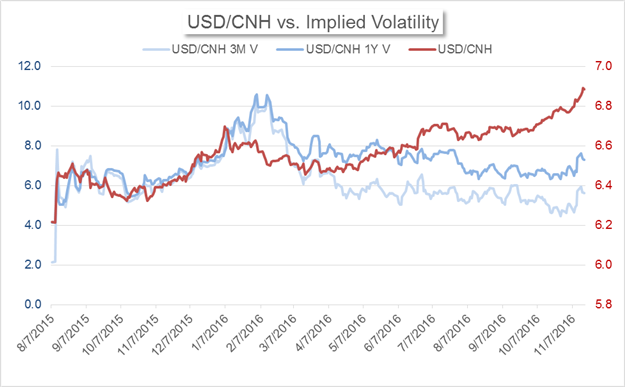
This daily digest focuses on Yuan rates, major Chinese economic data, market sentiment, new developments in China’s foreign exchange policies, changes in financial market regulations, as well as market news typically available only in Chinese-language sources.
– The implied volatility for the USD/CNH remains stable despite of record-setting levels.
– The electricity used by manufacturing companies increased at a faster pace in October.
– Chinese companies excluding banks, securities and insurances attracted 666.3 billion Yuan of foreign investment in January to October.
Yuan Rates
– The PBOC guided the Yuan lower against the U.S. Dollar for the 10th consecutive trading day on Thursday: the Yuan was weakened by -100 pips or -0.15% to 6.8692. As of 12:20PM EST, the onshore Yuan has bounced slightly with the USD/CNY dropping to below 6.87; the offshore Yuan has extended losses against its U.S. counterpart, with the USD/CNH trading around 6.892.
Despite that the Yuan has been setting records on almost daily basis, the implied volatility from the option market shows that investors remain relatively calm, unlike the panic that was seen in January to February. This is because Yuan’s losses against the Dollar is driven by the Dollar rally, an external factor, rather than the Yuan weakness, an internal factor. As of 12:20PM EST, the U.S. Dollar (via DXY) has soared 1.46% this week, while the onshore and offshore Yuan only lost 0.93% and 0.99% against it respectively.

Data Downloaded from Bloomberg; chart prepared by Renee Mu.
Following Trump’s win in the U.S. election, the implied volatility for the USD/CNH picked up again. Similar rallies were also seen in other Dollar pairs, such as the USD/JPY, EUR/USD and GBP/USD. This means that the increase in Yuan’s implied volatility was driven by external factor as well. As the December Fed rate hike is back on the table, the implied volatility for Dollar pairs steadies amid a clearer outlook of the Dollar.
















